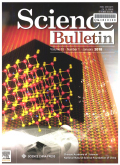- 钛学术文献服务平台 \
- 学术期刊 \
- 基础科学期刊 \
- 自然科学总论期刊 \
- 科学通报(英文版)期刊 \
New lepton non-universal forces in flavor physics?
New lepton non-universal forces in flavor physics?
基本信息来源于合作网站,原文需代理用户跳转至来源网站获取
摘要:
The Standard Model (SM) of particle physics succeeds in pre-dicting the vast majority of experimental high-energy data in terms of a minimal set of subatomic particles and their strong and electroweak interactions.However,while it is a self-consistent theory,the SM has many theoretical and empirical shortcomings 1.These suggest that the SM should be embedded into a richer framework with new particles and interactions becoming relevant at energies that could be as low as a tera-electronvolt(TeV).Discovering this new physics (NP) has become one of the major goals of the experiments currently gathering and analyzing data at CERN's Large Hadron Collider (LHC).One of these experi-ments,LHCb,might recently have struck gold.

推荐文章
Statistics matters in interpretations of non-traditional stable isotopic data
Isotopic data processing
Error propagation
Significant digits
Difference between means with uncertainties
ForCES路由器中网络管理机制的研究与实现
网络管理
ForCES路由器
简单网络管理协议
AgentX协议
ForCES体系结构路由器中RIP的研究与测试
控制器
转发器
ForCES
RIP
内容分析
关键词云
关键词热度
相关文献总数
(/次)
(/年)
引文网络
引文网络
二级参考文献 (0)
共引文献 (0)
参考文献 (0)
节点文献
引证文献 (0)
同被引文献 (0)
二级引证文献 (0)
2022(0)
- 参考文献(0)
- 二级参考文献(0)
- 引证文献(0)
- 二级引证文献(0)
引文网络交叉学科
相关学者/机构
期刊影响力
科学通报(英文版)
主办单位:
中国科学院
出版周期:
半月刊
ISSN:
1001-6538
CN:
11-1785/N
开本:
大16开
出版地:
北京东黄城根北街16号
邮发代号:
2-177
创刊时间:
1950
语种:
eng
出版文献量(篇)
9507
总下载数(次)
1
总被引数(次)
58070
期刊文献
相关文献
推荐文献
- 期刊分类
- 期刊(年)
- 期刊(期)
- 期刊推荐
力学
化学
地球物理学
地质学
基础科学综合
大学学报
天文学
天文学、地球科学
数学
气象学
海洋学
物理学
生物学
生物科学
自然地理学和测绘学
自然科学总论
自然科学理论与方法
资源科学
非线性科学与系统科学
科学通报(英文版)2022
科学通报(英文版)2021
科学通报(英文版)2020
科学通报(英文版)2019
科学通报(英文版)2018
科学通报(英文版)2017
科学通报(英文版)2016
科学通报(英文版)2015
科学通报(英文版)2013
科学通报(英文版)2012
科学通报(英文版)2011
科学通报(英文版)2010
科学通报(英文版)2009
科学通报(英文版)2008
科学通报(英文版)2007
科学通报(英文版)2006
科学通报(英文版)2005
科学通报(英文版)2004
科学通报(英文版)2003
科学通报(英文版)2002
科学通报(英文版)2001
科学通报(英文版)2000

 免费查重
免费查重










